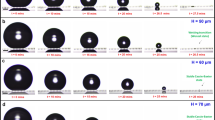Abstract
In this work, we have presented a new droplet splitting and transport mechanism using surface wetting phenomenon for lab on chip devices. The proposed methodology can be well utilized to split and transport a droplet without application of any external force or voltage. A 3D multiphase lattice Boltzmann algorithm with partial wetting surface is developed and simulated using D3Q19 model. A superhydrophobic surface is realized experimentally using a selective painting approach. The experimental results validated the predicted result. The surface free energy characteristics are obtained and analyzed with respect to time for droplet transportation.
Access this chapter
Tax calculation will be finalised at checkout
Purchases are for personal use only
Similar content being viewed by others
References
Fang, G., et al.: Droplet motion on designed microtextured superhydrophobic surfaces with tunable wettability. Langmuir 24(20), 11651–11660 (2008)
Novak, L., et al.: An integrated fluorescence detection system for lab-on-a-chip applications. Lab Chip 7(1), 27–29 (2007)
Pedersen, C.M., Mortensen, N.A.: Cell sorting using AC dielectrophoresis. Dissertation MS thesis, Department of Micro and Nanotechnology, Technical Univeristy of Denmark. Lyngby, Denmark (2006)
Pendharkar, G., Deshmukh, R., Patrikar, R.: Investigation of surface roughness effects on fluid flow in passive micromixer. Microsyst. Technol. 20(12), 2261–2269 (2014)
Luka, G., et al.: Microfluidics integrated biosensors: a leading technology towards lab-on-a-chip and sensing applications. Sensors 15(12), 30011–30031 (2015)
Jain, V., et al.: Design, fabrication and characterization of low cost printed circuit board based EWOD device for digital microfluidics applications. Microsyst. Technol. 23, 1–9 (2015)
Tang, G.H., Xia, H.H., Shi, Y.: Study of wetting and spontaneous motion of droplets on microstructured surfaces with the lattice Boltzmann method. J. Appl. Phys. 117(24), 244902 (2015)
Young, T.: An essay on the cohesion of fluids. Philos. Trans. R. Soc. Lond. 95, 65–87 (1805)
Pravinraj, T., Patrikar, R.: Modelling and investigation of partial wetting surfaces for drop dynamics using lattice Boltzmann method. Appl. Surf. Sci. 409, 214–222 (2017)
Jansen, H.P., et al.: Potential of lattice Boltzmann to model droplets on chemically stripe-patterned substrates. Appl. Surf. Sci. 361, 122–132 (2016)
Yuan, P., Schaefer, L.: Equations of state in a lattice Boltzmann model. Phys. Fluids 18(4), 042101 (2006)
Liu, L., Lee, T.: Wall free energy based polynomial boundary conditions for non-ideal gas lattice Boltzmann equation. Int. J. Mod. Phys. C 20(11), 1749–1768 (2009)
Schmieschek, S., Harting, J.: Contact angle determination in multicomponent lattice Boltzmann simulations. Commun. Comput. Phys. 9(05), 1165–1178 (2011)
Wu, L., et al.: Numerical simulations of droplet formation in a crossjunction microchannel by the lattice Boltzmann method. Int. J. Numer. Meth. Fluids 57(6), 793–810 (2008)
Shan, X., Chen, H.: Lattice Boltzmann model for simulating flows with multiple phases and components. Phys. Rev. E 47(3), 1815 (1993)
Gu, X., Gupta, A., Kumar, R.: Lattice Boltzmann simulation of surface impingement at high-density ratio. J. Thermophys. Heat Transfer 23(4), 773–785 (2009)
Song, D., et al.: Selectively splitting a droplet using superhydrophobic stripes on hydrophilic surfaces. Phys. Chem. Chem. Phys. 17(21), 13800–13803 (2015)
Acknowledgement
The authors would like to acknowledge NPMASS/ADA for the financial support for the establishment of a National MEMS design center at VNIT. We also thanks INUP (Indian Nano User Program) of CEN, IIT Bombay for providing the opportunity to carry out SEM characterization of the fabricated surfaces.
Author information
Authors and Affiliations
Corresponding author
Editor information
Editors and Affiliations
Rights and permissions
Copyright information
© 2017 Springer Nature Singapore Pte Ltd.
About this paper
Cite this paper
Pravinraj, T., Patrikar, R. (2017). Splitting and Transport of a Droplet with No External Actuation Force for Lab on Chip Devices. In: Kaushik, B., Dasgupta, S., Singh, V. (eds) VLSI Design and Test. VDAT 2017. Communications in Computer and Information Science, vol 711. Springer, Singapore. https://doi.org/10.1007/978-981-10-7470-7_66
Download citation
DOI: https://doi.org/10.1007/978-981-10-7470-7_66
Published:
Publisher Name: Springer, Singapore
Print ISBN: 978-981-10-7469-1
Online ISBN: 978-981-10-7470-7
eBook Packages: Computer ScienceComputer Science (R0)




